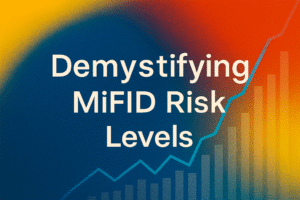
Demystifying MiFID Risk Levels:
From Regulation to Portfolio Construction
“Risk comes from not knowing what you are doing.” – Warren Buffett
MiFID II turns that maxim into law.
1. Why MiFID Risk Levels Matter
The Markets in Financial Instruments Directive II (MiFID II) forces investment firms in the EU/EEA to ask two fundamental questions before they let you invest:
- Is the product itself suitable for any retail investor? (“product governance”)
- Is this specific product suitable or appropriate for you? (“client suitability & appropriateness tests”)
To answer both efficiently, most firms collapse the multi‑layered MiFID rulebook into a single numeric risk scale (1–7). That common language lets advisers, robo‑platforms, and regulators compare products with investor profiles at a glance.
2. The 1 → 7 Ladder Explained
| Risk Level | Typical Annualised Volatility* | Representative Products | Investor Profile |
|---|---|---|---|
| 1 – Very Low | 0 – 2 % | Overnight deposits, money‑market funds, capital‑protected notes | Capital preservation only; no tolerance for loss. |
| 2 – Low | 2 – 5 % | Short‑dated sovereign bonds, term deposits | Conservative saver; accepts tiny drawdowns to beat inflation. |
| 3 – Low‑Medium | 5 – 8 % | Investment‑grade bond ETFs, covered‑bond funds | Cautious income seeker; patient but still risk‑averse. |
| 4 – Medium | 8 – 12 % | 60/40 balanced funds, global equity‑income funds | Balanced investor; long horizon, can weather 10–15 % dips. |
| 5 – Medium‑High | 12 – 20 % | Broad equity ETFs, high‑yield bonds, REITs | Growth‑oriented; comfortable with 20–30 % drawdowns. |
| 6 – High | 20 – 30 % | Emerging‑market equities, thematic/sector ETFs, unrated corporate bonds | Aggressive growth; rides large swings for higher returns. |
| 7 – Very High / Speculative | 30 % + | Single‑stock derivatives, leveraged & inverse ETPs, crypto ETPs, private equity | Speculator; accepts possibility of total loss for outsized gain. |
*Five‑year standard deviation or equivalent value‑at‑risk (VaR/ES) bucket. Institutions fine‑tune the cut‑offs.
3. Building the Investor Profile
Your Investor Profile (IP) is the outcome of a structured questionnaire covering:
| Dimension | Typical Questions | Why It Matters |
|---|---|---|
| Financial situation | Income, assets, liabilities, capacity for loss | Determines how much downside you can afford. |
| Investment objectives | Growth vs. income, target returns, time horizon | Anchors product selection and asset‑mix guidelines. |
| Knowledge & experience | Past products traded, years of investing, education | Influences the appropriateness test. |
| Risk tolerance | Behavioural & psychometric questions | Captures how much volatility you can stomach. |
Each answer is scored, weighted, and mapped onto the same 1 → 7 scale as products. The profile is dynamic: life events (new job, mortgage, retirement) should trigger a review.
4. Matching Product and Client Risk Levels
- Suitability test (advice & portfolio management)
Pass if IP ≥ Product Risk Level and the product furthers your stated objectives. - Appropriateness test (execution‑only trades)
Pass if your knowledge & experience justify the product’s complexity/risk (even if IP is lower). Otherwise the platform must display a clear warning.
When there is a mismatch, firms may:
- Block the trade outright (common for risk level 7 products).
- Require a signed execution‑only waiver.
- Recommend revisiting your IP questionnaire.
5. Best‑Practice Tips for Investors & Advisers
- Keep documents handy: KID/KIID & latest IP summary.
- Schedule annual reviews: Update after big life changes.
- Mind the liquidity lens: High risk often coincides with low liquidity.
- Diversify within limits: A Level 4 mandate may cap Level 6/7 exposure at e.g. 10 %.
- Use risk‑budget tools: Many robo‑platforms visualise remaining “risk budget” in real time.
6. Dictionary of Abbreviations & Key Terms
| Term / Abbreviation | Definition |
|---|---|
| AUM | Assets Under Management – total market value a firm oversees. |
| ETF | Exchange‑Traded Fund – fund trading intraday on an exchange. |
| IP (Investor Profile) | Quantified snapshot of an individual’s financial situation, objectives, knowledge, experience, and risk tolerance, mapped to a 1–7 scale. |
| KID | Key Information Document – PRIIPs disclosure for retail investors. |
| KIID | Key Investor Information Document – UCITS‑specific short‑form disclosure. |
| MiFID II | Markets in Financial Instruments Directive II – EU framework for markets, transparency, and investor protection. |
| PRIIPs | Packaged Retail and Insurance‑based Investment Products regulation requiring KIDs. |
| REIT | Real Estate Investment Trust – company owning or financing income‑producing real estate. |
| SRI | Summary Risk Indicator (1–7) printed in every KID. |
| SRRI | Synthetic Risk and Reward Indicator (1–7) in UCITS KIID, predecessor of SRI. |
| Suitability Test | Determines if a product matches an investor’s IP and objectives (advisory/managed accounts). |
| Appropriateness Test | Checks if a client has enough knowledge/experience for a complex/risky product (execution‑only trades). |
| VaR / ES | Value‑at‑Risk / Expected Shortfall – statistical measures of potential loss. |
| Volatility | Degree of price variation over time, usually measured by standard deviation. |
Key Takeaways
- One language: Both products and people are scored 1–7 → instant comparability.
- Dynamic profile: Your IP should evolve with your life, not stay static.
- Regulatory shield: The matching process protects investors and keeps firms compliant.
- Education wins: Raising your risk level responsibly requires demonstrable knowledge, not just bravado.
Stay informed. Stay protected. Invest wisely.
Mike Voss
